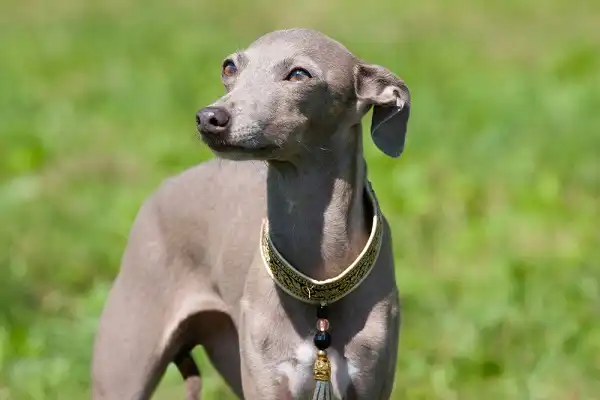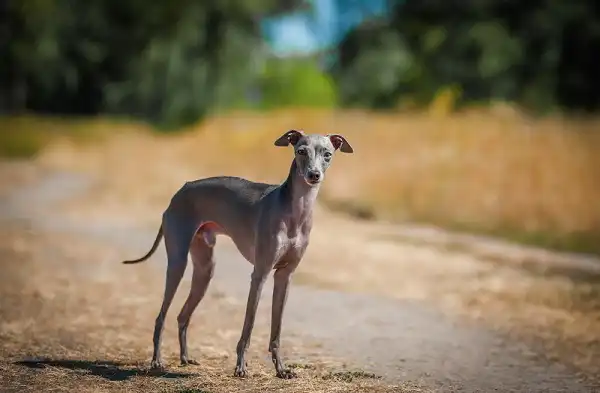If you’re looking for a small, affectionate companion that’s loyal and intelligent, the Italian Greyhound may be just what you need. These graceful dogs are low-maintenance when it comes to grooming and provide plenty of love with their sweet personalities. Their distinctive elegance is hard to ignore – sleek bodies adorned with short coats in stunning colors like cream, fawn, or blue steel – making them a wonderful addition to any home! In this blog post, we’ll explore the history of the beloved Italian Greyhound breed and outline why these beautiful canines will make an ideal pet for many families.

Italian Greyhound Description
The Italian Greyhound is a small breed that belongs to the Sighthound family. These elegant dogs have a slender and graceful build, with a sleek and shiny coat that comes in various colors including black, cream, grey, and fawn. Despite their small size, Italian Greyhounds are known for their athleticism and agility. They are highly intelligent and trainable, making them ideal pets for families who are looking for a companion that can keep up with their active lifestyle. These dogs are friendly and affectionate, making them great with kids and other pets.
The breed has a long and fascinating history that dates back to ancient Egyptian and Roman times. It is believed that Italian Greyhounds were originally bred as companions for royalty and nobility due to their regal appearance and gentle nature. In terms of grooming, Italian Greyhounds are very low-maintenance. They have short coats that don’t shed much, so regular brushing and an occasional bath are all that is required to keep them looking their best. Despite their small size, they have a lot of energy and require daily exercise to stay healthy and happy.
Italian Greyhound Habitat
Italian Greyhounds are adaptable to a variety of living spaces, making them suitable for both city and country living. However, their small size means they are particularly well-suited to apartment living, as they don’t need a lot of space to get the exercise they require. When kept indoors, they are calm and well-behaved, and usually content to curl up on a comfortable bed or couch. While Italian Greyhounds are primarily indoor dogs, they do like to get outside and explore, so a secure yard or park is ideal for playtime and exercise. Because they are sight hounds, they have a strong prey drive and may chase smaller animals if not properly socialized and trained. A securely fenced yard or a leash will keep them safe while allowing them to enjoy some outdoor time. Italian Greyhounds are sensitive to the cold and prefer to be kept warm, so a cozy bed or blanket is essential for them to snuggle up in. They also enjoy the company of their owners and other dogs, so if you are away from home for extended periods, it is recommended to either have a canine companion or arrange for a dog-sitter to keep them company and ensure they get the attention they need.
Italian Greyhound Diet
Proper nutrition is an essential component of ensuring the health and well-being of Italian Greyhounds. Like many small breeds, they have high energy levels and fast metabolism, which means they require a diet that is specifically formulated to meet their unique nutritional needs. A well-balanced diet for Italian Greyhounds should consist of high-quality protein sources, complex carbohydrates, healthy fats, and a wide range of vitamins and minerals. Foods rich in lean proteins, such as fish, chicken, and turkey, are an excellent choice for this breed as they provide the necessary amino acids for muscle growth and repair. Carbohydrates play a crucial role in providing energy for active dogs like Italian Greyhounds, and complex carbohydrates such as sweet potatoes, brown rice, and oatmeal should be the primary source of this nutrient in their diet. Adding fruits and vegetables to their meals not only provides essential vitamins and minerals but also helps to keep their digestive system healthy. Healthy fats are also important in a Greyhound’s diet, as they provide essential fatty acids that aid in the absorption of vitamins and minerals. Foods such as salmon, flaxseed, and coconut oil are great sources of healthy fats for this breed.

Italian Greyhound Size
When it comes to Italian Greyhound size, this breed is known for being small and sleek. They typically stand between 13 and 15 inches tall at the shoulder and weigh between 7 and 14 pounds. Despite their small size, they are known for their high energy levels and athleticism. Their small size and slender build make them well-suited for indoor living. Despite their small stature, Italian Greyhounds are not considered fragile or delicate. They are a sturdy breed that is built for athleticism and endurance. However, because they are small, they are more vulnerable to injury than larger breeds, and care should be taken to avoid rough play or activities that could lead to injury.
Italian Greyhound Lifespan
The Italian Greyhound is known for its petite size, but don’t let their small stature fool you; these dogs are capable of living a long and healthy life. In general, the Italian Greyhound’s lifespan ranges from 12 to 15 years, with some dogs living well into their senior years. However, with proper care and attention, it is not uncommon for this breed to exceed the average lifespan. Regular veterinarian check-ups are also essential for promoting a long and healthy life in Italian Greyhounds. These check-ups allow for early detection of any health issues, ensuring prompt treatment and care. With proper care and attention, Italian Greyhounds can live long, happy lives. Providing a healthy diet, regular exercise, and routine veterinary care can all contribute to a longer lifespan. While there is no guarantee that a dog will live a certain number of years, taking proactive steps to maintain their health and well-being can increase their chances of living a longer and healthier life.
Italian Greyhound Behavior
Italian Greyhounds are known for their charming personalities and playful behavior. They are friendly and affectionate, and they thrive on attention and human interaction. They are fiercely loyal and love nothing more than spending time with their families. While they are generally well-behaved, Italian Greyhounds can be stubborn at times, which can make training a bit challenging. However, with patience and consistency, they can be trained to obey basic commands and even perform tricks. One of the unique characteristics of Italian Greyhounds is their love for burrowing and snuggling under blankets. They are true lap dogs and will happily spend hours cuddled up with their owners. Another interesting behavior trait of Italian Greyhounds is their tendency to “sing” or howl when they are happy or excited. This vocalization is not a bark, but rather a high-pitched yodeling sound that is both comical and endearing. Italian Greyhounds are also known for their superb adaptability. They can thrive in a variety of living situations, from apartments to larger homes, and they can adapt to different schedules and lifestyles. However, they do require daily exercise and regular socialization.
Italian Greyhound Speed
Italian Greyhounds are known for their impressive speed and agility. Despite their small size, they are capable of reaching speeds of up to 40 miles per hour, making them one of the fastest dog breeds in the world. This incredible speed is due to their lean and muscular bodies, which are built for endurance and speed. Italian Greyhounds have a distinctive running style, which is often compared to that of a cheetah. They have long, slender bodies with powerful legs, allowing them to cover a lot of ground in a short amount of time. Their long, narrow muzzles also help to reduce wind resistance, allowing them to move through the air with ease.

Italian Greyhound Hunting
Italian Greyhounds have a rich history as hunting dogs, dating back to ancient times when they were prized for their speed and agility in catching small game. These elegant dogs were particularly valued by noblewomen in Renaissance Italy as they could be carried around in pockets or sleeves and released to chase after small animals. Despite their petite size, Italian Greyhounds were used in a variety of hunting scenarios, from chasing rabbits and hares to catching birds. They were often trained to hunt in packs, where their natural instincts to pursue prey were honed and refined over generations. Italian Greyhounds are sight hounds, meaning that they rely on their keen vision to track prey. Due to their small size, they could easily slip through tight spaces and navigate tricky terrain. Their slender, athletic build also allowed them to run at incredible speeds for extended periods, making them an ideal choice for hunting. While Italian Greyhounds are no longer used for hunting, their incredible instincts and love for chasing prey still shine through in their behavior today. Owners will often see their dogs dart after squirrels or rabbits during walks or runs.
Italian Greyhound Grooming and Maintenance
In addition to providing exercise and training, it is also important to stay on top of Italian Greyhound grooming and maintenance. While the breed’s short coat does not require much grooming, owners should regularly brush their dog’s fur and check for signs of parasites. As with all breeds, regular nail trimming, ear cleaning, and dental care are also essential in keeping your pet healthy. Italian Greyhounds are relatively low-maintenance dogs that do not require extensive grooming or upkeep. However, as with any pet, it is important to provide them with the necessary resources to keep them happy and healthy over a lifetime of companionship.
Italian Greyhound Health issues
While Italian Greyhounds are generally a healthy breed, there are some health issues specific to the breed that owners should be aware of. These include hip dysplasia, which can cause lameness in the hind legs; eye problems, such as progressive retinal atrophy and glaucoma; heart arrhythmia, which may lead to death if left untreated; and kneecap dislocation or luxating patellas. It is important for owners to watch out for any signs of distress or illness in their dogs and take them immediately to see a veterinarian if they have any concerns. For this reason, regular check-ups with your vet are recommended in order to monitor your pet’s physical well-being and detect potential medical issues before they become serious.

Conclusion
The Italian Greyhound is an incredibly unique and impressive breed, renowned for its speed, agility, and natural hunting instincts. They have a long history as loyal companions and excellent hunters, making them highly valued members of many households around the world. While they may no longer be used in hunting scenarios, their athleticism and keen vision still shine through when running off-leash or chasing small animals. It’s important to always provide these amazing dogs with a safe environment in which to exercise their physical abilities and practice their innate hunting skills. Overall, the Italian Greyhound is an extraordinary breed with many wonderful traits that make them an ideal pet for any household.
Frequently Asked Question


